Carson High Students Dom Cerniglia, Aaron Flieger, Edgar Avila, & Sergio Maqueda; Observing Scattered Disc Object, 99CY118
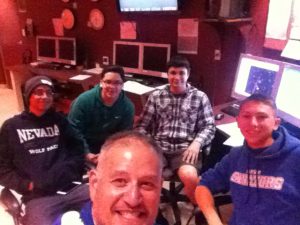
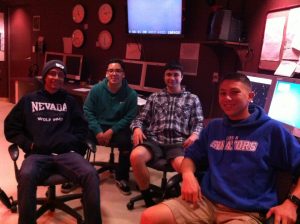
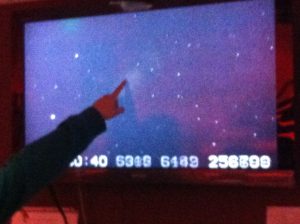

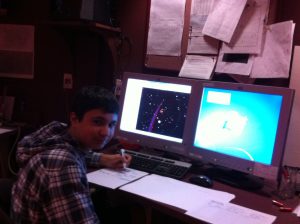
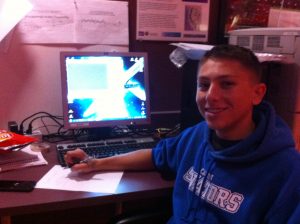
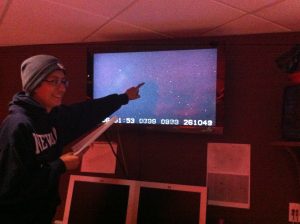

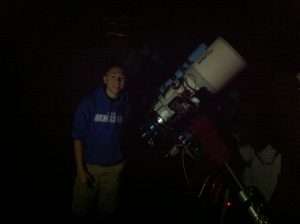
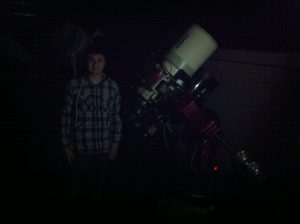

Carson High Students Dom Cerniglia, Aaron Flieger, Edgar Avila, & Sergio Maqueda; Observing Scattered Disc Object, 99CY118










Many RECON teams successfully recorded data from our double campaign earlier this week. Team are currently reporting their observations by submitting event reports and uploading video and logsheet files to SwRI in Boulder.
For our teams in the Northwest, there are four upcoming opportunities to connect and collaborate. Marc Buie will be hosting three RECON Meet-Ups this weekend:
Any and all community members are encouraged attend any of these opportunities to connect with other RECON teams and talk through questions about the project.
Also, NASA researcher scientist Dr. Bonnie Buratti will be giving a presentation on the Solar System at Ridgeview High School in Oregon on Friday, May 20. This is another opportunity for Oregon RECON teams to connect. Funds provided through Oregon State are available to help reimburse the cost of shuttling students to this event. To learn more email Amanda Schroeder, schroeam@oregonstate.edu. Feel free to contact Beverly (Schlegel) Vazquez at schlegeb@oregonstate.edu to ask me any questions you have about this event or if you are interested in hosting a table.
May Day is a day of celebration situated midway between the Spring Equinox and the Summer Solstice. This May will also be a busy RECON month! We wanted to share the following RECON events with our community.
Full campaign night involving two RECON events in early May
Monday, May 9 starting ~12:50AM PDT/MST (2016 May 09 ~07:50 UT)
Mother’s Day is on Sunday, May 8. Later than Sunday night/Monday morning, there are two promising RECON events. The first event, announced to the network back in early April, involves Classical Kuiper Belt Object 99HR11. This is a late event occurring just after midnight on the morning of Monday May 9.
Just last week, we received word from astronomers in South America that another event involving Centaur 02GZ32 has a very high probability of passing directly over the network on the same night. Marc and the RIO group are conducting observations and prediction work this week to pin down uncertainties on the shadow path. Given the possibility of discovering a ring system around this Centaur, we will be asking RECON team members to record this event as well if current predictions hold.
Marc will be visiting teams throughout Washington State the following weekend
Friday, May 13 PDT -Training Meetup in Okanogan
Saturday, May 14 PDT -Training Meetup in Ellensburg
Sunday, May 15 PDT – Training Meetup in The Dalles
Marc will be in Washington State the weekend of May 13-15. Similar to John’s trip through Oregon back in January, nearby teams are encouraged to join for one of the above mini-meetups as an opportunity to reconnect with other RECON team members and also to talk through any questions about the project. Times and locations will be provided shortly, along with a sign-up form to RSVP for these meet-ups.
Full Campaign involving Scattered Disc Object 99CY11 in late May
Wednesday, May 25 ~11:22 PDT/MST (2016 May 26 ~06:22 UT)
Toward the end of May, our seventh full RECON campaign involves Scattered Disk Object 99CY118, with an orbit that carries the object over twice as far from the Sun as Pluto! Thanks for completing the Pre-Event Confirmation Form at the link above.
2016 RECON Team Meeting in Carson City Nevada during early August
Wednesday-Friday, August 3-5 PDT
We have funding in our NSF award to host three team meetings between now and Fall 2019. We will be providing funding for 1 representative from each of our 55 communities to attend this meeting. Additional team members are also welcome, and we will have a block of extra hotel rooms at our conference rate. We will be providing a registration form to sign up for this event later this week.
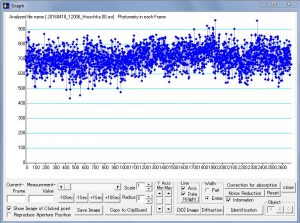
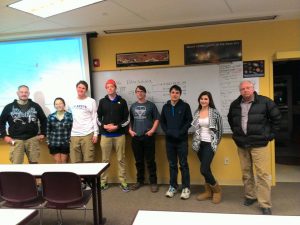
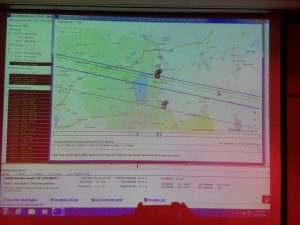
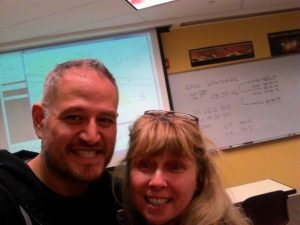
With Red Sumner, Patty Bean, and Carson High Students. Unfortunately we had a miss.
Just wanted to wish everyone in RECON a happy Spring Equinox, which occurs at 9:30PM PDT tonight (20 March @ 4:30 UT)!
We also wanted to take this moment thank the RECON network for a great year. Our Southern RECON teams met in Kingman, Arizona, one year ago today!
While entering RECON site coordinates into my IOTA (Occult4) site database I noticed several little known (to me) facts. I thought I would share these with the rest of the RECON community:
The RECON team network is a very widely spaced community of observation sites, spanning:
Way to go RECON!
Many occultation observations never make it to the analysis stage, as it is clear that the observation is either a negative (miss) or impossible to analyze due to outside effects such as clouds or technical problems. However, when there are difficulties it often pays to perform an analysis anyway, to make sure that something is not present in the video. The (268) Adorea observation by Chris Patrick is a perfect example.
(268) Adorea was advertized to the IOTA and RECON observers in Arizona, Nevada, and California. Three observers were able to observe the event and report results. The path map is shown here:
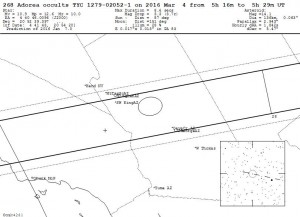
Chris Patrick near Kingman, AZ was the only person to get a positive video observation. Initially, he was not sure if there was anything on the video, due to the thin clouds that obscured the observation. Never-the-less, he submitted the video for analysis.
Tony George was able to review the video using both Limovie and R-OTE. Limovie produced a light curve as shown below:
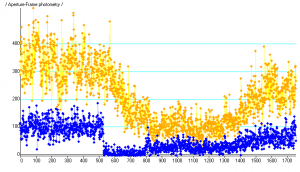
The blue light curve is the target star. The yellow light curve is a very nearby, slightly brighter, secondary star. Thin clouds obscured the occultation, causing both light curves to drop over the course of the observation. The blue light curve looks like ‘maybe’ there is an occultation, but it is hard to tell.
Because the secondary star was not occulted, it can be used as a ‘reference’ star by which the brightness of the target star an be normalized. The only variation of the brightness of the secondary star is due to dimming caused by passing clouds. If this dimming is normalized out of the target star light curve we can see if there was an occultation.
R-OTE was used to normalize the target star light curve. The resulting light curve is shown here:
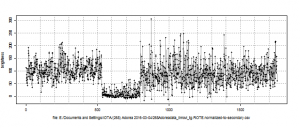
Now, there is a clear occultation event. Analysis showed the event to be nearly 8.9 seconds long, even longer than the maximum duration predicted for the event. This event, coupled with the two other chords — one positive and one miss — resulted in an estimate of the size and shape of Adorea as follows: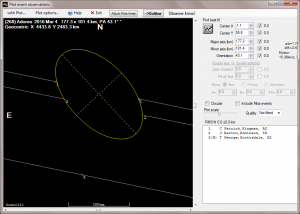
The key to the above result is the hard won observation obtained by Chris Patrick of the RECON team. Congratulations to Chris for this great observation.
There are many more good events occurring with paths crossing RECON teams in the month of March. Good luck to all who try these events.
Our first RECON manuscript has been published in The Astronomical Journal and featured in AAS Nova.
The paper describes the design and development of the RECON Project and will serve as an important technical reference for future results papers.
Thank you again to all of our RECON students, teachers, and community members for your continued contributions to this citizen science research effort!!!
Below are details for an optional RECON Main Belt Asteroid this Thursday evening. Team members in Parker, Havasu, Mohave Valley, Bullhead/Laughlin, Kingman, and Searchlight are well situated for this event. Feel free to sign up on OccultWatcher and/or let us know if you plan to observe. Again, this is an optional event, but great practice and a targeted opportunity for the above teams to get a positive occultation measurement and create object profile!
Date: 2016 March 4 UT
Recording Window: 05:27:00 – 05:28:00 UT
RA: 04:41:43 (of date)
DEC: 20:54:20 (of date)
Sense-Up: x4
Below is a starchart for the event:
This was the last event for February posted by Tony George. The event ocurred early evening on Feb 25 at around 7:38 PM (PST). Predicted event time was 03:38:34 UT February 26th. The target star (11.6 mag.) for the occultation was low in the west at 27 deg altitude and in the constellation Pisces. The predicted maximum duration was 1.6 seconds at the predicted centerline. On the Occult Watcher prediction map my location was just outside (2 km) on the south side of the shadow path in the 1 sigma zone. I had previously contacted Red Sumner at the Jack C. Davis Observatory to see if he could possibly observe. The observatory was only a few kilometers off the predicted centerline. Although partly cloudy most of the afternoon, the clouds started to clear by early evening and there appeared to be a good chance for an observations. Scope setup went quickly, but just before event time a small patch of cirrus moved over the field stars. I set the camera integration to 8X and the VirtualDub timer program to record for 5 minutes centered around the predicted time. Then it was just to hope for the best. Sure enough, the clouds cleared and almost exactly at the predicted time I observed a short ‘wink’ of the target star. A follow-up analysis by LiMovie confirmed an approx. 1.7 second occultaion event. Tony George was gracious enough to provide a formal R-OTE analysis as seen below.

The actual camera and VTI corrected duration was 1.670320 seconds. This event turned out to be one that could have been observed by as many as three RECON sites (Gardnerville, Yerington, and perhaps Hawthorne). It appears though that, as of this writing, I was the only positive observer. A formal report was filed with the IOTA using the OW IOTA Reporting plug-in which uses a simple Excel spreadsheet format.
Reported IOTA occultation results for all of North America can be viewed at : http://www.asteroidoccultation.com/observations/Results/